End Torture of Solitary Confinement
• California Prisoners Stand Against Civil Death
• Palestinian Prison Hunger Strikers Declare Solidarity With California Prison Hunger Strikers
•
Isolation, Indeterminate Sentences Used to Extract Confessions • The Case of the Angola Three • Confronting Torture in U.S. Prisons
California Prisoners Stand Against Civil Death
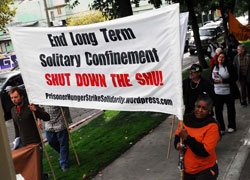 California prisoners resumed their hunger strike September 26. They initially organized a hunger strike for almost four weeks in July involving thousands of prisoners and supported by actions nationwide and internationally. The strike was suspended to give prison officials time to make good on their promises to meet the prisoners’ demands. These included an end to torture, forced confessions and solitary confinement as well as basic needs such as nutritional food.
California prisoners resumed their hunger strike September 26. They initially organized a hunger strike for almost four weeks in July involving thousands of prisoners and supported by actions nationwide and internationally. The strike was suspended to give prison officials time to make good on their promises to meet the prisoners’ demands. These included an end to torture, forced confessions and solitary confinement as well as basic needs such as nutritional food.
The prisoners contend with civil death, where their rights as human beings are denied by the state and federal government and their torture and solitary confinement enforced. Refusing to accept this continued repression and refusal of officials to make the needed changes, the prisoners are now set to resume their hunger strike. Voice of Revolution urges all to support the just struggle of the prisoners for rights. (For more information see http://prisonerhungerstrikesolidarity. wordpress.com).
Like many prisons across the U.S. the California Department of Corrections and Rehabilitation (CDCR) utilizes the torture of indefinite solitary confinement in what are called Security Housing Units or SHUs. Many people are kept in solitary for decades, denied any physical human contact and repeatedly subjected to state efforts to coerce them into naming their fellow prisoners as “gang members” or “gang affiliates” in order to be released from the SHUs.
The branding as “gang members” is then used to send yet more prisoners into the SHUs while justifying the government claim that the SHUs are used for the “worst of the worst” supposed “gang generals.” The branding is commonly based on innocuous non-criminal activity or association, such as speaking to a fellow prisoner, and/or the coerced testimony of confidential informants, who themselves face prison and solitary if they do not name names.Most of the people initially imprisoned are there for non-violent drug offenses on cases that never went to trial but instead involved plea bargains (only 3-5 percent of criminal cases go to trial).
The decades-long practice of torture, coercion and civil death used in the state and federal prisons is also used more broadly in the population, such as for the mass round-ups of Arabs and Muslims following September 11. Much of the torture carried out in prisons like Guantánamo was first tested and perfected in U.S. prisons against mostly national minority prisoners. Many of those imprisoned were guilty of no crime and jailed solely on the basis of “testimony” from government informants.
The “gang” label, like the “terrorist” label serves to justify torture and other brutal attacks on human rights in government efforts to break the people imprisoned and secure additional informants. It is also a means to repress and criminalize resistance using state terrorism, inside and outside of the prisons. This can be seen in the government move now to brand “any disruptive group” as a gang, with members subject to indefinite detention and solitary confinement. As well, for those in the SHUs, many are being targeted for being political, for organizing for rights inside the prisons, including defending fellow inmates from unjust treatment.
All of these practices violate the U.S. Constitution, including its requirements for due process and outlawing of cruel and unusual punishment. They also go against international legal principles. The readiness of the government at the state and federal level to openly pursue and justify these inhuman practices is indicative of the lawless state violence being imposed by rulers who have no solutions to the social problems the people face. And despite this state terrorism, the California prisoners are again going on hunger strike and taking their stand for justice.
Voice of Revolution salutes the courageous resistance of the prisoners who are refusing to accept inhuman and unjust conditions and organizing under very difficult circumstances. Their firm stand for rights and their refusal to submit to state organized terrorism inspires all to carry forward in resisting government crimes and developing a democracy of our own making, where such crimes are not permitted and the people themselves are decision makers.
[TOP]
Palestinian Prison Hunger Strikers Declare Solidarity With California Prison Hunger Strikers
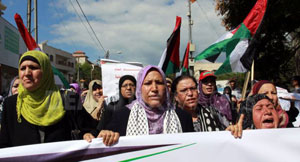 Solidarity with Palestinian prisoners is more urgent than ever. Since the announcement of Palestinian prisoners’ hunger strike against the isolation of Ahmad Sa’adat and all other prisoners held in solitary confinement, and against torture and humiliation for prisoners and their families and visitors, Israeli prison officials have stepped up their threats against Palestinian prisoners participating in the hunger strike.
Solidarity with Palestinian prisoners is more urgent than ever. Since the announcement of Palestinian prisoners’ hunger strike against the isolation of Ahmad Sa’adat and all other prisoners held in solitary confinement, and against torture and humiliation for prisoners and their families and visitors, Israeli prison officials have stepped up their threats against Palestinian prisoners participating in the hunger strike.
The strike began Tuesday, September 27. The Israeli minister of internal security, at a meeting in Ramon and Naqab Prisons, has threatened to escalate repression against prisoners, threatening to move all prisoners participating in the hunger strike into isolation and solitary confinement and to forcibly transfer those prisoners to other prisons in the occupation prison system. Prisoners are frequently transferred by occupation forces in an attempt to break up social bonds and disrupt organizing against prison repression.
Israeli prison guards put down a Palestinian prisoner uprising. For decades, Palestinian prisoners have engaged in hunger strikes to demand – and win – their rights, putting their bodies on the line once more to demand the freedom and dignity of themselves, their people, their homeland and their nation. Palestinian prisoners have announced that they will not be moved from their course by the threats of the occupiers. Prisoners’ representatives have confirmed that Sa’adat and fellow isolated leader Jamal Abu al-Haija, in isolation with Sa’adat, will join in the strike themselves.
Furthermore, prisoners announced that they will reject all prison orders, refusing to wear uniforms, stand up for daily counts or accept food. The situation is more urgent than ever as prisoners begin their strike. The Campaign to Free Ahmad Sa’adat calls upon all solidarity, international justice and human rights groups and organizations to join us to demand freedom, dignity and justice for Palestinian prisoners.
Solidarity with Prison Hunger Strikers in California
The Campaign to Free Ahmad Sa’adat expresses its deepest solidarity with the prisoners on hunger strike in Pelican Bay, California, in the United States. These prisoners, inside the racist and brutal U.S. prison system, have also stood together on hunger strike to demand an end to abuse and the use of isolation against prisoners, particularly long-term isolation, to demand proper food, and an end to torture and abuse.
They ended their strike in July 2011 after receiving assurances that their demands would be met; however, this has not happened, and prisoners have in fact been punished and further repressed for participating in the strike. The prisoners in California resumed their hunger strike on Monday, September 26, 2011.
 Across the world, prisoners stand on hunger strike, demanding dignity and justice. The Campaign to Free Ahmad Sa’adat salutes the California hunger strikers, expresses our deepest solidarity, and joins in their demands for dignity and justice. We also note the great leaders and great struggles that have emerged from the racist dungeons of U.S. prisons, from Attica to Soledad. The Campaign to Free Ahmad Sa’adat salutes the political prisoners in U.S. jails and the Guantanamo torture camp – and all jails in the world – including Mumia Abu-Jamal, Leonard Peltier, Ghassan Elashi and hundreds more, and demands their freedom.
Across the world, prisoners stand on hunger strike, demanding dignity and justice. The Campaign to Free Ahmad Sa’adat salutes the California hunger strikers, expresses our deepest solidarity, and joins in their demands for dignity and justice. We also note the great leaders and great struggles that have emerged from the racist dungeons of U.S. prisons, from Attica to Soledad. The Campaign to Free Ahmad Sa’adat salutes the political prisoners in U.S. jails and the Guantanamo torture camp – and all jails in the world – including Mumia Abu-Jamal, Leonard Peltier, Ghassan Elashi and hundreds more, and demands their freedom.
Ahmad Sa’adat is the General Secretary of the Popular Front for the Liberation of Palestine and a member of the Palestinian Legislative Council. One of nearly 10,000 Palestinian political prisoners, he has been sentenced to 30 years in Israeli prisons, mainly for a speech he made following the Israeli assassination of his predecessor, Abu Ali Mustafa, in August 2001. The systematic assassination, imprisonment and detention of Palestinian political leaders has long been a policy of the Israeli state, as reflected in the imprisonment of Sa’adat and over 20 other members of the Palestinian Legislative Council, targeted for their involvement in and commitment to the struggle for the liberation of their land and people. Learn how you can help him and all the Palestinian hunger strikers at the Campaign to Free Ahmad Sa’adat at http://www.freeahmadsaadat.org.
[TOP]
Isolation, Indeterminate Sentences
Used to Extract Confessions
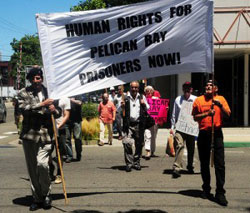 The conditions at Security Housing Units (SHU) at Pelican Bay Prison, and other Supermax prisons, clearly constitute torture and/or cruel, inhumane treatment of prisoners. It relies on the use of severe isolation or solitary confinement, the effects of which I have written about before in the context of the Bradley Manning case. At Pelican Bay, the prisoners in “administrative segregation” are locked in a gray concrete 8 x 10 foot cell 22-1/2 hours per day. The other time (if that privilege is granted) is spent alone in a tiny concrete yard. There is no human physical contact. No work, no communal activities. If the prisoner has enough money they can purchase a TV or radio. Meals are pushed through a slot in the metal door.
The conditions at Security Housing Units (SHU) at Pelican Bay Prison, and other Supermax prisons, clearly constitute torture and/or cruel, inhumane treatment of prisoners. It relies on the use of severe isolation or solitary confinement, the effects of which I have written about before in the context of the Bradley Manning case. At Pelican Bay, the prisoners in “administrative segregation” are locked in a gray concrete 8 x 10 foot cell 22-1/2 hours per day. The other time (if that privilege is granted) is spent alone in a tiny concrete yard. There is no human physical contact. No work, no communal activities. If the prisoner has enough money they can purchase a TV or radio. Meals are pushed through a slot in the metal door.
An end to solitary confinement, and in particular to long-term solitary confinement, of an indeterminate nature, is one of five “core” demands of the hunger strikers.
Another key demand concerns the onerous and sinister “debriefing” process. The prisoners are asking the California Department of Corrections and Rehabilitation (CDCR) to:
A) cease the use of innocuous associatio n to deny an active status,
B) cease the use of informant/debriefer allegations of illegal gang activity to deny inactive status, unless such allegations are also supported by factual corroborating evidence, in which case CDCR-PBSP staff shall and must follow the regulations by issuing a rule violation report and affording the inmate his due process required by law.
Dr. Corey Weinstein elaborated on the “debriefing process” in an article at Prison Legal News:
“More than 50 percent of the men in SHU are assigned indeterminate terms there because of alleged gang membership or activity. The only program that the California Department of Corrections and Rehabilitation (CDCR) offers to them is to debrief. The single way offered to earn their way out of SHU is to tell departmental gang investigators everything they know about gang membership and activities including describing crimes they have committed. The Department calls it debriefing. The prisoners call it “snitch, parole or die.” The only ways out are to snitch, finish the prison term or die. The protection against self incrimination is collapsed in the service of “anti-gang” investigation.”
The “debriefing” process is set up by statute [in California, other states and federally]. It is a long-term process, whereby the prisoner “volunteers” to “debrief,” i.e., to snitch on other prisoners and identify them as “gang” members. The debriefing prisoners are segregated in their own unit for many months, often more than a year. If they fail to finish the “debriefing” process, they lose whatever credits towards good behavior and release they may have accumulated during the debriefing process.
Arbitrary Nature of “Debriefing”
[The debriefing process is arbitrary and used to secure confessions and false testimony against other inmates.]
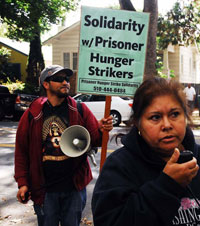 In January 2010, the CDCR determined that no prisoner who was a “validated gang member” in a SHU could earn credits toward earlier release. For those who had volunteered to “debrief in exchange for release from SHU, this meant even if they followed the rules and even though they had agreed to snitch (or make up incriminating evidence) about other purported gang-affiliated prisoners, they would not get released. According to the legal brief in one case, “During a hearing with the chief deputy warden on September 23, 2010, petitioner inquired why his original release date had not been reinstated, given that he had submitted all of the information that had been requested of him with regard to debriefing. On September 29, 2010, petitioner was informed that he ‘was “on the list” but the “list” was very long and that is why it was taking so long.’ A few days later, Sampson told prison officials he “was no longer interested in debriefing because the institution had not honored its bargain with [him] to grant credits in exchange for debriefing…”
In January 2010, the CDCR determined that no prisoner who was a “validated gang member” in a SHU could earn credits toward earlier release. For those who had volunteered to “debrief in exchange for release from SHU, this meant even if they followed the rules and even though they had agreed to snitch (or make up incriminating evidence) about other purported gang-affiliated prisoners, they would not get released. According to the legal brief in one case, “During a hearing with the chief deputy warden on September 23, 2010, petitioner inquired why his original release date had not been reinstated, given that he had submitted all of the information that had been requested of him with regard to debriefing. On September 29, 2010, petitioner was informed that he ‘was “on the list” but the “list” was very long and that is why it was taking so long.’ A few days later, Sampson told prison officials he “was no longer interested in debriefing because the institution had not honored its bargain with [him] to grant credits in exchange for debriefing…”
The reasoning of the Appellate Court in this case tells us a great deal about how state authorities define who is or is not a “validated” gang member. In the end, a prisoner’s refusal to engage in the debriefing process supposedly proved he was a gang member, and worthy of administrative segregation (or long-term solitary confinement). The court stated:
“… petitioner’s ineligibility for conduct credit accrual is not punishment for the offense of which he was convicted. Nor is it punishment for gang-related conduct that occurred prior to January 25, 2010, since petitioner was not stripped of conduct credits he had already accrued. It is punishment for gang-related conduct that continued after January 25, 2010.
“Petitioner maintains he “did nothing” after January 25, 2010 to bring himself within the ambit of the amended statute, but we see the matter differently. ‘Gangs, as defined in [California Code of Regulations, title 15] section 3000, present a serious threat to the safety and security of California prisons,’ and ‘[i]nmates and parolees shall not knowingly promote, further or assist any gang as defined in section 3000.’ (In re Furnace (2010) 185 Cal.App.4th 649, 657.) The “validation” of a gang member involves no more and no less than the CDCR’s recognition of at least three reliable, documented bases (“independent source items”) for concluding that an inmate’s background, person, and/or belongings indicate his or her active association with other validated gang members or associates, and at least one of those bases constitutes a direct link to a current or former validated gang member or associate. (Ibid.; See Cal. Code Regs., tit. 15, §§ 3378, 3321.) For purposes of placement in a SHU, active gang membership or affiliation is considered “conduct [that] endangers the safety of others or the security of the institution” and “a validated prison gang member or associate is deemed to be a severe threat to the safety of others or the security of the institution” warranting an indeterminate SHU term. (Cal. Code Regs., tit. 15, § 3341.5, subd. (c) & subd. (c)(2)(A)(2).)
“Once “validated,” an inmate’s continued active membership or affiliation in the gang and placement in a SHU continues until one of three things happens: (1) the periodic, 180-day review of the inmate’s status by the classification committee results in his or her release to the general inmate population or (2) he or she becomes eligible “for review of inactive [gang] status” after six years of noninvolvement in gang activity (Cal. Code Regs., tit. 15, § 3378, subd. (e)); or (3) he or she initiates and completes the “debriefing process,” thereby demonstrating that he or she has dropped out of the gang. (Cal. Code Regs., tit. 15, § 3378.1.) Unless and until one of these three eventualities come to pass, an inmate continues to engage in the misconduct that brings him or her within the amendment’s ambit.”
The Appeal court was even more concrete in a later portion of the brief, when they stated, “By aborting the process, petitioner demonstrated that after January 25, 2010, he continued to associate with the gang, continued to pose a threat to prison security, and continued to warrant housing in a SHU. ” In other words, if you do not participate in their snitch program, you must, by the logic of the prison authorities, be an active gang member. Review of possible “inactive gang status” takes place “after six years” of solitary confinement, assuming the prison authorities determine you to have been “inactive” during this time. But meanwhile, there is a long “list” of debriefing or debriefed prisoners, any of whom, after many, many months of interrogation by prison officials, may have fingered you as gang member.
According to the California Code of Regulations, Title 15, Section 3315, there are 23 “serious rule violations” that can send an inmate to a SHU for a determinate time. These include “acts of disobedience or disrespect” or the perceived “threat to commit” a disruption or breach of security, including the “threat” to “possess a controlled substance.” They also include “acquisition or exchange of personal or state property amounting to more than $50…. tattooing or possession of tattoo paraphenalia…. possession of $5 or more without authorization…. [and] refusal to work or participate in a program as assigned,” among others. As well “mass disruptive conduct,” is included in these codes.
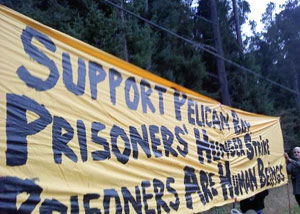 The parallels with the regime instituted by Department of Defense officials at Guantánamo are stunning. Simply replace “gangs” with “Islamic jihadists.” And, as at Guantánamo, the emphasis is on coercing cooperation and collaboration with state authorities, with an emphasis on fingering other prisoners, and thereby building up a case for an even greater threat against state authorities, who must have recourse to even more coercion and wielding of state power, all in the name of security, even while constructing the bricks for the edifice of fear out of the very actions of state repression they exercise.
The parallels with the regime instituted by Department of Defense officials at Guantánamo are stunning. Simply replace “gangs” with “Islamic jihadists.” And, as at Guantánamo, the emphasis is on coercing cooperation and collaboration with state authorities, with an emphasis on fingering other prisoners, and thereby building up a case for an even greater threat against state authorities, who must have recourse to even more coercion and wielding of state power, all in the name of security, even while constructing the bricks for the edifice of fear out of the very actions of state repression they exercise.
Indeed, the techniques that were used as torture at Guantánamo, Bagram and various “black site” prisons (including, perhaps the new CIA black sites) were originally conceived in U.S. prisons to fully “exploit” the prisoner, including production of false confessions and the recruitment of double agents and informants. […]
From Pelican Bay to Guantánamo Bay, the practice of unnecessarily harsh prison conditions, amounting to torture, needs to end. The hunger strikers at Pelican Bay and elsewhere are putting their lives on the line for the sake of basic human dignity. We need to take note and take action.
[TOP]
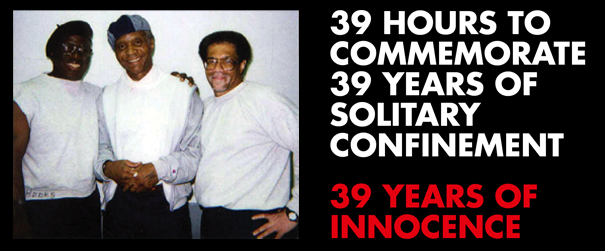
Thirty-nine years ago, deep in rural Louisiana, three young black men were silenced for trying to expose continued segregation, systematic corruption, and horrific abuse in the biggest prison in the U.S., an 18,000 acre former slave plantation called Angola.
Peaceful, non-violent protest in the form of hunger and work strikes organized by inmates caught the attention of Louisiana’s elected leaders and local media in the early 1970s. They soon called for investigations into a host of unconstitutional and extraordinarily inhumane practices commonplace in what was then the “bloodiest prison in the South.” Eager to put an end to outside scrutiny, prison officials began punishing inmates that were organizers.
Herman Wallace, Albert Woodfox, and Robert King were targeted and charged with murders they did not commit and thrown into 6x9 foot solitary cells.
Robert was released in 2001, but Herman and Albert remain in solitary, continuing to fight for their freedom.
The State’s case is riddled with inconsistencies, obfuscations, and missteps. A bloody print at the murder scene does not match Herman, Albert or anyone charged with the crime and was never compared with the limited number of other prisoners who had access to the dormitory on the day of the murder.
Potentially exculpatory DNA evidence has been “lost” by prison officials — including fingernail scrapings from the victim and barely visible “specks” of blood on clothing alleged to have been worn by Albert.
Both Herman and Albert had multiple alibi witnesses with nothing to gain who testified they were far away from the scene when the murder occurred.
In contrast, several State witnesses lied under oath about rewards for their testimony. The prosecution’s star witness Hezekiah Brown told the jury: “Nobody promised me nothing.” But new evidence shows Hezekiah, a convicted serial rapist serving life, agreed to testify only in exchange for a pardon, a weekly carton of cigarettes, TV, birthday cakes, and other luxuries.
“Hezekiah was one you could put words in his mouth,” the Warden reminisced chillingly in an interview about the case years later.
Even the widow of the victim after reviewing the evidence believes Herman and Albert’s trials were unfair, has grave doubts about their guilt, and is calling upon officials to find the real killer.
Albert’s conviction has now been overturned twice by judges citing racial discrimination, prosecutorial misconduct, inadequate defense, and suppression of exculpatory evidence. But judgment has been deferred to Louisiana, where vengeful prosecutors insist Albert is “the most dangerous person on the planet.”
Although a State Judicial Commissioner similarly recommended reversing Herman’s conviction based on new, compelling evidence exposing prosecutorial misconduct and constitutional violations, the Louisiana Supreme Court denied his appeal without comment. Undeterred, Herman has now turned to the Federal Courts to prove his innocence and win his freedom. Louisiana prison officials stubbornly refuse to release them from solitary because “there’s been no rehabilitation” from “practicing Black Pantherism.”
Nearly a decade ago Herman, Albert and Robert filed a civil lawsuit challenging the inhumane and increasingly pervasive practice of long-term solitary confinement. Magistrate Judge Dalby describes their almost four decades of solitary as “durations so far beyond the pale” she could not find “anything even remotely comparable in the annals of American jurisprudence.” The case, expected to go to trial soon, will detail unconstitutionally cruel and unusual treatment and systematic due process violations at the hands of Louisiana officials.
As the Angola 3 have done, now is the time to challenge injustice and demand that the innocent and wrongfully incarcerated be freed.
Write the Angola 3
Herman Wallace
#76759
Elayn Hunt Correctional Center
CCR - D - #11
PO Box 174
St Gabriel, LA 70776
Albert Woodfox
#72148
David Wade Correctional Center, N1A
670 Bell Hill Rd.
Homer, LA 71040
Robert King [TOP]
c/o Kings Freelines
2008 New York Ave. #B
Austin, Texas 78702
kingsfreelines@ gmail.com • 512-473-0680
Confronting Torture in U.S. Prisons
Pelican Bay is “home” to U.S. prisoner Hugo Pinell, imprisoned now for a total of 47 years and held at Pelican Bay since 1990. Pinell has been in continuous solitary for over 40 years, since at least 1971— probably even since the late 1960s. He, along with Herman Wallace and Albert Woodfox of the Angola 3, who have been kept in solitary for 39 years, are all known for their efforts to organize inside the prisons. They are being kept in solitary for what one prison official said was their “continuing Black Pantherism.” They are prisoners who recognized the significance of organization as necessary to build resistance and they have been brutalized and kept in isolation for that stand. Despite the decades-long effort to break them, these and many other prisoners are organizing as a collective to defend their rights and urge all to do the same.
Hugo Pinell was a close comrade of Black Panther leader George Jackson, who organized a Panther chapter inside California’s San Quentin Prison, similar to the prison chapter organized by the Angola 3 in Louisiana. On August 21, 1971, the day of George Jackson’s assassination by prison officials, three prison guards and two inmate trustees were also killed. Subsequently, six prisoners, including Hugo Pinell, were singled out and put on trial. Reminiscent of the slave auctions, they were each forced to bear 30 pounds of chains in a Marin County courtroom after being charged with numerous counts of murder and assault. They became known as the San Quentin Six and broad efforts to free them were organized, as also occurred and continues with the Angola 3.
We provide below excerpts from an interview by Angola 3 News with James Ridgeway and Jean Casella, co-founders of the Solitary Watch, which provides information on the widespread use of the torture of solitary confinement in U.S. prisons and the struggle by prisoners and rights activists to end it.
* * *
Angola 3 News: How did you first become interested in the issue of solitary confinement and ultimately become inspired to start Solitary Watch?
Solitary Watch: We started Solitary Watch because this issue grabbed us by the throats. The solitary confinement of tens of thousands of prisoners may be the most grievous mass human rights violation that’s taking place on American soil, yet it has been largely concealed from and ignored by the public, and seriously under-reported by the press. Solitary confinement and prison inmates in general remain remarkably invisible and dehumanized, considering that they now number nearly 2.3 million and constitute one in every 100 adults in this country.
A3N: What is a SHU?
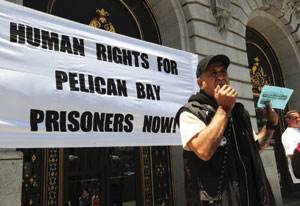 SW: SHU is just one of many euphemisms prison systems have developed to avoid using the term “solitary confinement.” In California, it stands for Security Housing Unit; in New York it is Special Housing Unit. Elsewhere we see Special Management Units, Behavioral Management Units, Communications Management Units, Administrative Segregation, Disciplinary Segregation — the list goes on. There are nuances of difference among them, but they all consist of 23- to 24-hour-a-day lockdown. Most of these systems — including the federal Bureau of Prisons — deny that they use solitary confinement, even while they have tens of thousands of prisoners locked alone in their cells for months, years, even decades.
SW: SHU is just one of many euphemisms prison systems have developed to avoid using the term “solitary confinement.” In California, it stands for Security Housing Unit; in New York it is Special Housing Unit. Elsewhere we see Special Management Units, Behavioral Management Units, Communications Management Units, Administrative Segregation, Disciplinary Segregation — the list goes on. There are nuances of difference among them, but they all consist of 23- to 24-hour-a-day lockdown. Most of these systems — including the federal Bureau of Prisons — deny that they use solitary confinement, even while they have tens of thousands of prisoners locked alone in their cells for months, years, even decades.
Solitary confinement was actually invented here in the United States, in the early 19th century in Philadelphia, as a supposedly humane alternative to things like floggings and hard labor. Prisoners were locked up alone, with absolutely nothing to do but contemplate their crimes, pray, and supposedly become “penitent”— thus the term “penitentiary.” Of course, nothing like that happened. The U.S. Supreme Court looked at conditions in the Philadelphia prison in 1890 and found that “A considerable number of the prisoners fell, after even a short confinement, into a semi-fatuous condition, from which it was next to impossible to arouse them, and others became violently insane; others still, committed suicide; while those who stood the ordeal better were not generally reformed, and in most cases did not recover sufficient mental activity to be of any subsequent service to the community.”
For nearly 100 years after that, solitary confinement was rare; the famous Birdman of Alcatraz spent six years in solitary, and that was unusual. Things really began to change in 1983, [with] the notorious Marion Lockdown, where prisoners were permanently confined to their cells without yard time, work, or any kind of rehabilitative programming [at the federal prison in Marion, Illinois.]
Other prisons followed suit, and in 1989 California built the first supermax — Pelican Bay. There was a supermax boom in the 1990s, and today, 40 states and the federal government have supermax prisons holding upwards of 25,000 inmates. Tens of thousands more are held in solitary confinement in lockdown units within other prisons and jails. There is no up-to-date nationwide count, but according to best estimates, there are at least 75,000 and perhaps more than 100,000 prisoners in solitary confinement on any given day in the U.S.
Solitary confinement has become the disciplinary measure of first resort. Today you can be placed in solitary confinement not only for violence, but for any form of “insubordination” toward prison officials. ...A lot of the men in Pelican Bay’s SHU are there because they have been “validated” as gang members, based on the say-so of inmate “snitches” who are rewarded for informing.
A3N: What are effects of the SHU on prisoners’ health and well-being?
SW: As one prisoner at the Tamms supermax in Illinois said, “Lock yourself in your bathroom for the next 10 years and tell me how it will affect your mind.”
If it were not already obvious enough, research conducted over the last 30 years confirms solitary confinement has an extremely damaging effect on mental health. One study found that a single week in solitary produced a change in EEG activity related to stress and anxiety. There is evidence that long-term isolation profoundly alters the brain chemistry, and that longer stretches in solitary produce psychopathologies — including panic attacks, depression, inability to concentrate, memory loss, self-mutilation, and various forms of psychosis — at a considerably higher rate than other forms of confinement.
It is important to acknowledge, also, that a huge number of prisoners who are placed in solitary suffer from underlying mental illness. After 40 years of cuts to funding for mental health care, prisons and jails in general — and solitary confinement cells in particular — have become America’s new asylums. Prisoners are placed in solitary for being “disruptive,” when what they are doing is simply exhibiting the untreated symptoms of mental illness. One report by Human Rights Watch found that in prison systems around the country, one-third to one-half of the prisoners held in solitary were mentally ill. Other studies have found that two-thirds of all prison suicides take place in solitary confinement.
There has been less research done on the physical effects of solitary confinement, but evidence from recent court cases suggests a relationship to things like extreme insomnia, joint pain, hypertension and even damage to the eyesight — which makes sense when you are talking about not being able to walk or look more than ten feet in any direction for years or decades on end.
A3N: Do you think the policies being protested at Pelican Bay are violations of international human rights standards? Of domestic U.S. laws?
SW: There is no doubt that solitary confinement, as it is practiced in the United States at Pelican Bay and elsewhere, stands in violation of international human rights standards, including the UN Convention Against Torture and Other Cruel, Inhuman, or Degrading Treatment or Punishment, and the UN’s Basic Principles for the Treatment of Prisoners. […]
California is particularly bad when it comes to holding prisoners in solitary confinement indefinitely based on highly questionable determinations of gang status, which as we said are often based on a system of snitching in return for various rewards. These prisons have made a science out of isolation. The cells usually measure between 60 and 80 square feet, and those cells are a prisoner’s entire world. They are fed through slots in the solid steel doors, and if they communicate with prison staff, including mental health practitioners, that also takes place through the feeding slot. If they are lucky they get to exercise one hour a day, alone, in a fenced or walled “dog run,” and leave their cells a few times a week to take a shower — in shackles, of course. In some cells the lights are on 24 hours a day, and there is round-the-clock video surveillance.
A3N: Considering th e political context of solitary confinement in Hugo Pinell’s case, as well as that of the Angola 3, what does this says about how prison authorities use solitary confinement as a political tool against prisoner activists and organizers?
SW: There is no doubt that solitary confinement is widely employed against prisoners who are perceived as representing any kind of threat to the absolute power and control of prison authorities. This is true even if inmates are seeking to organize for positive change and even if they are completely nonviolent.
[TOP]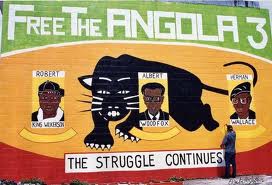 In the case of Herman Wallace and Albert Woodfox, the two still-imprisoned members of the Angola 3, and of Hugo Pinell at Pelican Bay, we are talking about men who have had virtually clean disciplinary records for several decades, and who are now in their sixties. The fact that they continue to be held in solitary confinement clearly has everything to do with their involvement as prison organizers. We have the warden of Angola, Burl Cain, saying under oath in a deposition that Wallace and Woodfox have to be kept in solitary because they are still “trying to practice Black Pantherism,” and if he let them into the general population they would “organize the young new inmates” and “have the blacks chasing after them.” We have a prisoner in California being sent to the SHU simply for having reading materials written by George Jackson and contact information for Hugo Pinell. In Massachusetts, an inmate was sent to solitary after he tried to expose a sex-for-snitching ring run by guards at his prison; they said his offense was “engaging in or inciting a group demonstration or hunger strike.” A prison journalist in Maine was isolated and eventually shipped out of state for sending broadcasts called “Live from the Hole” to a local radio station. Solitary confinement is routinely used to punish prison whistleblowers, and to suppress nonviolent dissent and free expression. […]
In the case of Herman Wallace and Albert Woodfox, the two still-imprisoned members of the Angola 3, and of Hugo Pinell at Pelican Bay, we are talking about men who have had virtually clean disciplinary records for several decades, and who are now in their sixties. The fact that they continue to be held in solitary confinement clearly has everything to do with their involvement as prison organizers. We have the warden of Angola, Burl Cain, saying under oath in a deposition that Wallace and Woodfox have to be kept in solitary because they are still “trying to practice Black Pantherism,” and if he let them into the general population they would “organize the young new inmates” and “have the blacks chasing after them.” We have a prisoner in California being sent to the SHU simply for having reading materials written by George Jackson and contact information for Hugo Pinell. In Massachusetts, an inmate was sent to solitary after he tried to expose a sex-for-snitching ring run by guards at his prison; they said his offense was “engaging in or inciting a group demonstration or hunger strike.” A prison journalist in Maine was isolated and eventually shipped out of state for sending broadcasts called “Live from the Hole” to a local radio station. Solitary confinement is routinely used to punish prison whistleblowers, and to suppress nonviolent dissent and free expression. […]
